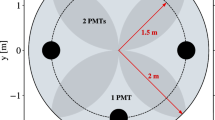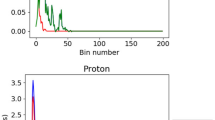Abstract
This paper presents several approaches to deal with the problem of identifying muons in a water Cherenkov detector with a reduced water volume and 4 PMTs. Different perspectives of information representation are used, and new features are engineered using the specific domain knowledge. As results show, these new features, in combination with the convolutional layers, are able to achieve a good performance avoiding overfitting and being able to generalise properly for the test set. The results also prove that the combination of state-of-the-art machine learning analysis techniques and water Cherenkov detectors with low water depth can be used to efficiently identify muons, which may lead to huge investment savings due to the reduction of the amount of water needed at high altitudes. This achievement can be used in further research to be able to discriminate between gamma and hadron-induced showers using muons as discriminant.




Similar content being viewed by others
Notes
1 Gigaelectronvolt (GeV) = \(10^{9}.\) eV.
1 Teraelectronvolt (TeV) = \(10^{12}.\) eV.
References
LeCun Y, Boser B, Denker J, Henderson D, Howard R, Hubbard W, Jackel L (1989) Handwritten digit recognition with a back-propagation network. Adv Neural Inf Process Syst 2:396
Kiranyaz S, Avci O, Abdeljaber O, Ince T, Gabbouj M, Inman DJ (2021) 1D convolutional neural networks and applications: a survey. Mech Syst Signal Process 151:107398. https://doi.org/10.1016/j.ymssp.2020.107398
Erhan L, Ndubuaku M, Di Mauro M, Song W, Chen M, Fortino G, Bagdasar O, Liotta A (2021) Smart anomaly detection in sensor systems: a multi-perspective review. Inf Fusion 67:64. https://doi.org/10.1016/j.inffus.2020.10.001
Banan A, Nasiri A, Taheri-Garavand A (2020) Deep learning-based appearance features extraction for automated carp species identification. Aquacult Eng 89:102053
Fan Y, Xu K, Wu H, Zheng Y, Tao B (2020) Spatiotemporal modeling for nonlinear distributed thermal processes based on KL decomposition. MLP LSTM Netw IEEE Access 8:25111
Shamshirband S, Rabczuk T, Chau KW (2019) A survey of deep learning techniques: application in wind and solar energy resources. IEEE Access 7:164650
Sainath T.N, Vinyals O, Senior A, Sak H (2015) Convolutional, long short-term memory, fully connected deep neural networks, 2015 IEEE international conference on acoustics, speech and signal processing (ICASSP), pp 4580–4584
Peimankar A, Puthusserypady S (2021) DENS-ECG: A deep learning approach for ECG signal delineation. Expert Syst Appl. https://doi.org/10.1016/j.eswa.2020.113911
Manzano M, Guillén A, Rojas I, Herrera LJ, Deep Learning Using EEG Data in Time and Frequency Domains for Sleep Stage Classification, in Advances in Computational Intelligence - 14th International Work-Conference on Artificial Neural Networks, IWANN 2017, Cadiz, Spain, June 14-16, 2017, Proceedings, Part I, Lecture Notes in Computer Science, vol. 10305, ed. by I. Rojas, G. Joya, A. Català (Springer, 2017), Lecture Notes in Computer Science, vol. 10305, pp. 132–141. https://doi.org/10.1007/978-3-319-59153-7_12
Guillén A, Bueno A, Carceller J, Martínez-Velázquez J, Rubio G, Peixoto CT, Sanchez-Lucas P (2019) Deep learning techniques applied to the physics of extensive air showers. Astroparticle Phys 111:12. https://doi.org/10.1016/j.astropartphys.2019.03.001
Guillén A, Martínez J, Carceller JM, Herrera LJ (2020) A comparative analysis of machine learning techniques for muon count in UHECR extensive air-showers. Entropy. https://doi.org/10.3390/e22111216
Capistrán T, Torres I, Altamirano L (2015) New method for Gamma/Hadron separation in HAWC using neural networks, arXiv preprint arXiv:1508.04370
Choma N, Monti F, Gerhardt L, Palczewski T, Ronaghi Z, Prabhat P, Bhimji W, Bronstein M, Klein S, Bruna J (2018) Graph neural networks for icecube signal classification, in 2018 17th IEEE international conference on machine learning and applications (ICMLA) (IEEE) , pp 386–391
De Angelis A, Pimenta M (2018) Introduction to particle and astroparticle physics: multimessenger astronomy and its particle physics foundations, Introduction to particle and astroparticle physics: multimessenger astronomy and its particle physics foundations (Springer)
Assis P, Conceição R, Pimenta M, Tomé B, Blanco A, Fonte P, Lopes L, de Almeida UB, Shellard R, Piazzoli BD, et al., LATTES: a novel detector concept for a gamma-ray experiment in the Southern hemisphere,
Zuñiga-Reyes A, Hernández A, iranda-Aguilar A, Sandoval A, Martínez-Castro J, Alfaro R, Belmont E, León H, Vizcaya AP (2017) Detection of vertical muons with the HAWC water Cherenkov detectors and its application to gamma/hadron discrimination, arXiv preprint arXiv:1708.09500
Barber A, Kieda D, Springer W, Collaboration H, et al., (2017) Detection of Near Horizontal Muons with the HAWC Observatory, in ICRC, 301, 512
Zuo X et al (2015) Design and performances of prototype muon detectors of LHAASO-KM2A. Nucl Instrum Meth A 789:143. https://doi.org/10.1016/j.nima.2015.04.010
Carrillo-Perez F, Herrera L, Carceller J, Guillén A (2021) Deep learning to classify ultra-high-energy cosmic rays by means of PMT signals, Neural Computing and Applications pp 1–17
Assunção F, Correia J, Conceição R, Pimenta MJM, Tomé B, Lourenço N, Machado P (2019) Automatic design of artificial neural networks for gamma-ray detection. IEEE Access 7:110531
Heck D, Knapp J, Capdevielle J, Schatz G, Thouw T (1998) A Monte Carlo code to simulate extensive air showers, Report FZKA 6019
Agostinelli S, Allison J, Amako KA, Apostolakis J, Araujo H, Arce P, Asai M, Axen D, Banerjee S, Barrand G et al (2003) GEANT4-a simulation toolkit. Nucl Inst Methods Phys Res Sect A Accelerat Spectro Detect Assoc Equip 506(3):250
IEEE Transactions on Nuclear Science 53 No. 1, 270 (2006)
Nuclear Instruments and Methods in Physics Research A 835, 186 (2016)
Southern Wide field Gamma-ray Observatory (SWGO) https://www.swgo.org/SWGOWiki/doku.php
González BS, Conceição R, Tomé B, Pimenta M, Herrera LJ, Guillen A (2020) Using convolutional neural networks for muon detection in WCD tank. J Phys Conf Series 1603:012024. https://doi.org/10.1088/1742-6596/1603/1/012024
Chawla NV, Bowyer KW, Hall LO, Kegelmeyer WP (2002) SMOTE: synthetic minority over-sampling technique. J Artif Int Res 16(1):321–357
Guillén A, Todero C, Martínez JC, Herrera LJ (2018) A Preliminary Approach to Composition Classification of Ultra-High Energy Cosmic Rays, in international conference on applied physics, system science and computers (Springer) pp 196–202
Kiranyaz S, Avci O, Abdeljaber O, Ince T, Gabbouj M, Inman D.J (2019) 1D convolutional neural networks and applications: A survey, arXiv preprint arXiv:1905.03554
Carrillo-Perez F, Herrera LJ, Carceller JM, Guillén A (2019) Improving Classification of Ultra-High Energy Cosmic Rays Using Spacial Locality by Means of a Convolutional DNN, in international work-conference on artificial neural networks (Springer) pp 222–232
Manzano M, Guillén A, Rojas I, Herrera L.J (2017) Combination of EEG Data Time and Frequency Representations in Deep Networks for Sleep Stage Classification, in international conference on intelligent computing (Springer ), pp 219–229
Goodfellow I, Bengio Y, Courville A (2016)Deep Learning, Deep Learning (MIT Press). http://www.deeplearningbook.org
Kisel’ák J, Lu Y, Švihra J, Szépe P, Stehlík M, (2020)“SPOCU”: scaled polynomial constant unit activation function, Neural Computing and Applications pp 1–17
Khessiba S, Blaiech AG, Khalifa KB, Abdallah AB, Bedoui MH (2020) Innovative deep learning models for EEG-based vigilance detection, Neural Computing and Applications pp 1–17
Kingma DP, Ba J (2014) Adam: a method for stochastic optimization, arXiv preprint arXiv:1412.6980
Herrera LJ, Todero Peixoto CJ, Baños O, Carceller JM, Carrillo F, Guillén A (2020) Composition classification of ultra-high energy cosmic rays. Entropy 22(9):998
Breiman L (2001) Random forests. Mach Learn 45(1):5
Friedman JH (2001)Greedy function approximation: a gradient boosting machine, Annals of statistics pp 1189–1232
Chen T, Guestrin C (2016)Xgboost: A scalable tree boosting system, in Proceedings of the 22nd acm sigkdd international conference on knowledge discovery and data mining , pp 785–794
Shahhosseini M, Hu G, Pham H (2019)Optimizing ensemble weights and hyperparameters of machine learning models for regression problems, arXiv preprint arXiv:1908.05287
Storn R, Price K (1997) Differential evolution-a simple and efficient heuristic for global optimization over continuous spaces. J Glob Optim 11(4):341
Pedregosa F, Varoquaux G, Gramfort A, Michel V, Thirion B, Grisel O, Blondel M, Prettenhofer P, Weiss R, Dubourg V, Vanderplas J, Passos A, Cournapeau D, Brucher M, Perrot M, Duchesnay E (2011) Scikit-learn: machine learning in python. J Mach Learn Res 12:2825
Oliphant TE (2007) Python for scientific computing. Comput Sci Eng 9(3):10. https://doi.org/10.1109/MCSE.2007.58
Chollet F et al. (2015)Keras. GitHub, https://github.com/fchollet/keras
xgboost developers. (2020) XGBoost Python Package. https://xgboost.readthedocs.io/en/latest/python/index.html
Acknowledgements
We would like to thank to A. Bueno for all the support and useful discussions during the development of this work. The authors thank also for the financial support by OE - Portugal, FCT, I. P., under project PTDC/FIS-PAR/29158/2017. R. C. is grateful for the financial support by OE-Portugal, FCT, I. P., under DL57 /2016/cP1330/cT0002. A. G. is grateful for the financial support by the projects MINECO FPA2017-85197-P and PID2019-104676GB-C32. B.S.G. is grateful for the financial support by grant LIP/BI - 14/2020, under project IC&DT, POCI-01-0145-FEDER-029158.
Author information
Authors and Affiliations
Corresponding author
Ethics declarations
Conflict of interest
The authors declare that they have no conflict of interest.
Additional information
Publisher's Note
Springer Nature remains neutral with regard to jurisdictional claims in published maps and institutional affiliations.
Rights and permissions
About this article
Cite this article
González, B.S., Conceição, R., Pimenta, M. et al. Tackling the muon identification in water Cherenkov detectors problem for the future Southern Wide-field Gamma-ray Observatory by means of machine learning. Neural Comput & Applic 34, 5715–5728 (2022). https://doi.org/10.1007/s00521-021-06730-z
Received:
Accepted:
Published:
Issue Date:
DOI: https://doi.org/10.1007/s00521-021-06730-z




